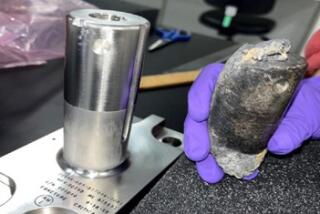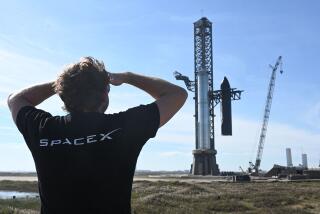Debris May Be Shuttle Booster : Find Could Provide Clues to Explosion
- Share via
KENNEDY SPACE CENTER, Fla. — One of two solid rocket boosters from the space shuttle Challenger was believed to have been detected on the sea floor Tuesday by a National Aeronautics and Space Administration recovery ship.
A brief and cautiously worded NASA statement issued here in the late afternoon reported that “sonar soundings indicate a solid rocket booster may have been located.”
The statement did not provide any information about the condition of the debris, its location or, most importantly, which of the two boosters was thought to have been found.
The hope among NASA officials was that the submerged booster was the Challenger’s right booster rocket, which could prove crucial to the effort to identify the precise source of the Jan. 28 explosion that killed the seven Challenger crew members.
NASA officials on Saturday released photographs of what they call an “unusual plume” spewing from the right solid rocket booster seconds before the explosion. It is believed the plume represented a leak from the 149-foot-long rocket that overheated an adjoining fuel tank, sparking the explosion.
“If you could by any prayer find the right-hand booster it would be fantastic,” said Jim Mizell, a NASA spokesman. “This would be worth its weight in gold to compare with our backup data.”
Shortly after the shuttle blew up, NASA officials had said that the boosters were destroyed by remote control detonations because one appeared to have been headed for the Florida coast.
Booster Prime Suspect
The detonation had been viewed as potentially devastating to the search for a cause, since from the outset the right booster has been seen as a prime suspect in the disaster.
However, Mizell said Tuesday that much of the booster casing could have survived the remote-controlled detonation. He explained that the charge is planted in the rocket in a manner that knocks off its nose cone and slices the rocket lengthwise. This action deprives the booster of its thrust, and it drops straight into the water.
Mizell said the force of the detonation and its impact splashing into the ocean might have caused extensive damage. But he added that the rockets casings are constructed of thick, solid steel.
Burn patterns on the rocket and the condition of seams between its four main sections would be among evidence that the booster could yield, Mizell said.
The discovery came on the first day when nearly all search activity was concentrated on the seafloor. A large fleet of military vessels had worked vast sections of the Atlantic for a week, fishing 12 tons of floating debris from the 300-ton spacecraft out of the water.
However, since the harvest of floating wreckage declined sharply, the number of search ships was cut in half, and NASA said its focus would shift to identifying objects on the seafloor.
Seven objects were viewed by submersible cameras on Tuesday and eliminated as possible Challenger debris. Ten more objects, however, held out greater promise, the space agency said.
Report Corrected
NASA also corrected a report it issued on Monday that a sunken helicopter and light airplane had been located inadvertently in the Challenger search. The report had prompted questions about when the aircraft crashed, who might have been in them, and what was going to be done to retrieve them.
On Tuesday, however, NASA explained that the helicopter and airplane mentioned had been detected flying in the region by radar on the day of the shuttle explosion. The helicopter and airplane were presumed to have landed safely, and there was no further explanation about how the radar readings of airbound craft came to be confused with underwater sonar readings.
In a further clarification, Coast Guard officials said early reports that searchers had been told to look for an extremely toxic green canister also were erroneous.
“There was no green canister,” said a Coast Guard spokesman.
Meanwhile, NASA officials denied as false a CBS report, based on monitored radio transmissions between search vessels, that parts of Challenger’s crew cabin and some personal effects have been found.
More to Read
Sign up for Essential California
The most important California stories and recommendations in your inbox every morning.
You may occasionally receive promotional content from the Los Angeles Times.











